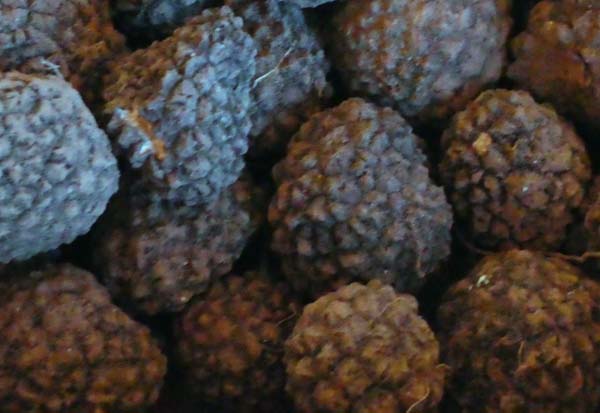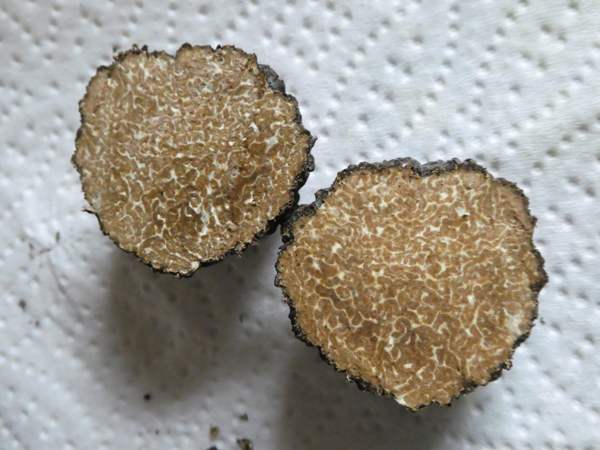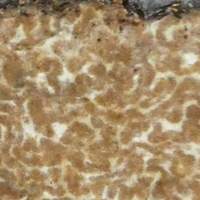Tuber aestivum Vittad. - Summer Truffle
Phylum: Ascomycota - Class: Pezizomycetes - Order: Pezizales - Family: Tuberaceae
Distribution - Taxonomic History - Etymology - Identification - Culinary Notes - Reference Sources

Tuber aestivum, the Summer Truffle, grows in mycorrhizal relationship with the root systems of Beech trees on lime-rich soil.
The variety of Summer Truffle found in Britain and other northern European countries is sometimes referred to as the Burgundy Truffle, Tuber aestivum var. uncinatum. The Burgundy Truffle was formerly treated as a separate species, Tuber uncinatum, but molecular analysis has shown that the Summer Truffle and Burgundy Truffle are the same species.

Differences in taste and odour were the original reasons for the two forms of Tuber aestivum being treated as separate species. Even their spores displayed some morphological distinctions, but it is now believed that all of these differences are due solely to ecological rather than evolutionary factors.
Distribution
The Summer Truffle or Burgundy Truffle is known to occur throughout Europe, including the UK and Ireland where it is a rare find. Being subterranean, these mushrooms are rarely seen by people walking in woodlands, and so their frequency of occurrence is a matter of conjecture (or of commercial secrecy if you are a truffle merchant!).
Taxonomic history
When in 1831 Italian mycologist Carlo Vittadini (1800 - 1865) described the Summer Truffle he gave it the scientific binomial name Tuber aestivum, and that is still its generally-accepted scientific name.
Tuber mesentericum Vittad. is a synonym of Tuber Aestivum.
Etymology
Tuber, the generic name, comes directly from the Latin word tuber, meaning a lump or swelling. The specific epithet aestivum comes from the Latin aestivus meaning summer.
Identification guide
 |
FruitbodyTypically 3 to 6cm across but occasionally much larger, the fruitbodies are usually more or less spherical but occasionally irregular and multi-lobed; the outer surface is dark brown or black and covered in irregular pyramidal warts. Inside, the spore-bearing material is initially white, becoming beige or grey-brown and marbled by white membranes in a random rather than regular pattern. |
SporesEgg-shaped, 20- 45 x 18-35µm; ornamented with a coarse irregular reticulum. Spore massCreamy white or yellowish in mass. |
|
Habitat & Ecological role |
Ectomycorrhizal, found most often under Beech trees but very occasionally under oaks, always on alkaline soil. Like other edible truffles the Summer Truffle is found mainly in southern Europe, although its northern spread is such that these truffles can be found by diligent searchers in many more countries including Britain and even Scandinavia. |
Season |
Harvesting is from early summer until mid autumn, although in mild winters it is possible to find Summer Truffles as late as the beginning of January. |
Similar species |
The Périgord Truffle Tuber melanosporum has a blackish surface covered in small crazed polygonal sections with shallow rivers between them; its spore-laden interior is darker than that of the Summer Truffle. The Piedmont White Truffle Tuber magnatum has a pale smooth exterior and a cream or ochre interior. |
Culinary Notes
Summer Truffles are highly-prized edible fungi, although their aroma and flavour are not generally considered to be in the same league as Piedmont White Truffle or Perigord Truffles. Truffles are so expensive to buy that tey are generally shaved very thinly and added sparingly to a meal. One way to make a truffle go further is to extract 'truffle oil' from the fruitbody and use it as a spray. Most so-called truffle oil available in shops does not contain truffles at all but is produced synthetically to replicate (to some degree!) the unique odour of real truffles.
Reference Sources
Fascinated by Fungi, 2nd Edition, Pat O'Reilly 2016, reprinted by Coch-y-bonddu Books in 2022.
Dennis, R.W.G. (1981). British Ascomycetes; Lubrecht & Cramer; ISBN: 3768205525.
Breitenbach, J. & Kränzlin, F. (1984). Fungi of Switzerland. Volume 1: Ascomycetes. Verlag Mykologia: Luzern, Switzerland.
Medardi, G. (2006). Ascomiceti d'Italia. Centro Studi Micologici: Trento.
Dictionary of the Fungi; Paul M. Kirk, Paul F. Cannon, David W. Minter and J. A. Stalpers; CABI, 2008
Taxonomic history and synonym information on these pages is drawn from many sources but in particular from the British Mycological Society's GB Checklist of Fungi.
Acknowledgements
This page includes pictures kindly contributed by Margaret Vernon.
Fascinated by Fungi. Back by popular demand, Pat O'Reilly's best-selling 450-page hardback book is available now. The latest second edition was republished with a sparkling new cover design in September 2022 by Coch-y-Bonddu Books. Full details and copies are available from the publisher's online bookshop...

